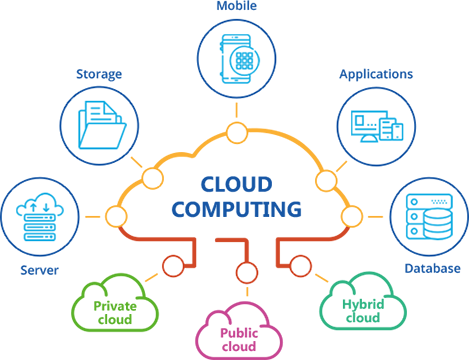LinkDaddy Cloud Services Revealed: Expert Techniques for Cloud Services Press Release Excellence
LinkDaddy Cloud Services Revealed: Expert Techniques for Cloud Services Press Release Excellence
Blog Article
Simplify Your Infrastructure With Cloud Services
As services browse the ever-evolving landscape of innovation and data administration, the function of cloud services in simplifying infrastructure has actually ended up being significantly famous. Exactly how can organizations efficiently navigate this shift and absolutely open the potential of cloud solutions for simplifying their facilities?
Benefits of Cloud Solutions
Cloud services offer a streamlined approach to handling IT facilities, supplying services with versatility, scalability, and cost-efficiency. Among the key benefits of cloud solutions is the scalability they use. Organizations can easily scale their resources up or down based on demand, guaranteeing they only spend for what they use. This versatility is particularly useful for services with rising and fall requirements or those experiencing growth.
In addition, cloud solutions remove the demand for organizations to purchase pricey software and hardware. This cost-efficiency is a substantial benefit, specifically for little to medium-sized business looking to decrease upfront costs. By utilizing cloud services, organizations can access top notch IT resources without the significant cost related to traditional framework arrangements.
Furthermore, cloud solutions supply organizations with the adaptability to access their data and applications from anywhere with a net link. This level of accessibility enhances partnership amongst teams, makes it possible for remote work, and increases overall productivity. The versatility offered by cloud services empowers companies to adapt quickly to transforming market problems and consumer needs.
Price Financial Savings and Scalability
Along with the operational advantages highlighted earlier, the combination of cloud services right into a company's facilities brings forth substantial expense savings and enhanced scalability. Cloud solutions use a pay-as-you-go model, permitting services to range resources up or down based upon current needs, thus avoiding the expenses related to keeping excess ability. This flexibility allows companies to adapt promptly to fluctuating demands without incurring unneeded expenses.
Moreover, cloud services eliminate the need for upfront financial investments in equipment and software, reducing funding expenses. Business expenses are also minimized as firms no much longer need to manage and keep physical servers, leading to lower energy consumption and IT staffing prices. In addition, cloud solutions offer automated updates and upkeep, making sure that the facilities stays safe and secure and current without calling for hand-operated interventions.
Enhanced Protection Procedures
When integrating cloud services right into a firm's infrastructure to guard sensitive information and make certain conformity with market regulations,Implementing strict security procedures is paramount. Cloud provider use enhanced safety features such as information security, firewall program protection, and multi-factor verification to reduce cybersecurity risks. Encryption assists safeguard data both at rest and en route, ensuring that only authorized customers can access delicate information. Firewalls function as a barrier between outside hazards and interior networks, tracking and managing outbound and inbound network web traffic. Multi-factor verification adds an extra layer of protection by calling for users to provide numerous kinds of confirmation before accessing the cloud solutions.
In addition, normal security audits and compliance analyses help determine susceptabilities and make sure adherence to market criteria. Firms can also take advantage of features like automated protection updates and real-time danger tracking given by cloud provider. By prioritizing protection actions and staying positive in resolving potential dangers, services can confidently leverage cloud services while shielding their useful data from unauthorized access or violations.
Transitioning to Cloud Framework
To successfully integrate cloud services right into a business's infrastructure, an organized strategy that addresses the change towards cloud-based services is vital. Transitioning to cloud infrastructure entails mindful planning and implementation to ensure a smooth migration process - cloud services press release.
When the analysis is full, a migration approach should be created. This strategy must outline the timeline, resources, and responsibilities for relocating each component to the cloud. It is important to interact this plan clearly to all stakeholders to make certain positioning and reduce disruptions throughout the transition.
During the migration process, screening and monitoring are critical to identify and attend to any type of issues quickly. Normal checkpoints need to be established to track progress and make necessary adjustments. In addition, training for workers on making use of cloud solutions ought to be given to ensure a successful change and optimize the benefits of the new infrastructure.
Finest Practices for Cloud Adoption
Effective adoption of cloud solutions hinges on the strategic alignment of service goals with technical capabilities and organizational preparedness. To make sure a smooth transition to the cloud, organizations ought to begin by carrying out a detailed assessment of their existing facilities and determining which work are best fit for cloud migration. It is vital to entail essential stakeholders from different departments in the decision-making process to get buy-in and attend to any kind of worries early on.
One more best method for cloud adoption is to prioritize security and compliance. Organizations has to meticulously examine the protection actions supplied by cloud service suppliers and make sure that their data is safeguarded according to sector criteria and regulatory requirements. Implementing durable information security, gain access to controls, and normal safety audits can assist mitigate risks related to cloud fostering.

Verdict

As services navigate the ever-evolving landscape of innovation and data monitoring, the cloud services press release function of cloud services in streamlining framework has come to be progressively famous - Cloud Services. Just how can businesses properly navigate this transition and really unlock the capacity of cloud services for simplifying their framework?
Cloud services offer a structured strategy to managing IT framework, supplying organizations with cost-efficiency, adaptability, and scalability. By utilizing cloud solutions, organizations can access top quality IT sources without the significant price tag linked with standard facilities arrangements.
To make sure a smooth shift to the cloud, organizations need to begin by carrying out a detailed evaluation of their present infrastructure and identifying which work are best fit for cloud movement.
Report this page